 n the art and poetry associated with Pre-Raphaelitism and Aestheticism, the chained woman, the sleeping woman, the dead woman, and the sculpted woman provided central themes. These states of passivity allow the male to reduce the woman, even through her death, to a composition of his own creating. In both The Perseus Cycle and The Briarose Series, the male hero assumes the roles of rescuer and animator. These roles are taken a step further in The Pygmalion Series when the male becomes the sole creator of his feminine ideal. In both The Perseus Cycle and The Pygmalion Series, Burne-Jones turns to the classicizing world of myth and paints subjects suspended in an arcadian timelessness. Burne Jones's women exist in an immobile world of myth and represent some ponderous literary or aesthetic idea.
n the art and poetry associated with Pre-Raphaelitism and Aestheticism, the chained woman, the sleeping woman, the dead woman, and the sculpted woman provided central themes. These states of passivity allow the male to reduce the woman, even through her death, to a composition of his own creating. In both The Perseus Cycle and The Briarose Series, the male hero assumes the roles of rescuer and animator. These roles are taken a step further in The Pygmalion Series when the male becomes the sole creator of his feminine ideal. In both The Perseus Cycle and The Pygmalion Series, Burne-Jones turns to the classicizing world of myth and paints subjects suspended in an arcadian timelessness. Burne Jones's women exist in an immobile world of myth and represent some ponderous literary or aesthetic idea.
Burne-Jones turned to William Morris's The Earthly Paradise for a poetic narrative of the Perseus legend under the title "The Doom of King Acrisius." Most critics characterized Burne-Jones's treatment of the legend as dispassionate. The art critic of the Times commented on how "action itself is conveyed in a strangely individual way; it is not so much action as the spirit of action" (Wildman 1998: 222). In his cycle of paintings, Burne-Jones concentrates on the episodes of the hero's search for the Gorgon Medusa and his rescue of Andromeda. The colors that predominate in the oils, the idiosyncratic tones of deep blue, green and yellow reinforce Burne-Jones's wish to convey in his paintings "a beautiful romantic dream of something that never was, never will be -- in a light better than any light that ever shone in a land no one can define or remember, only desire" (Wood 1981: 119).
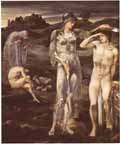 Usually the aesthetic and decorative qualities of the figures and the entire composition are paramount in the art of later Pre-Raphaelites and Decadents, but in The Perseus Series, narrative is also important. The The Calling of Perseus combines two scenes from Morris's narrative. In the left middle-ground of the painting, the goddess Pallas approaches the dejected figure of Perseus, and in the foreground, Pallas reveals herself to the startled Perseus. An enemy of the gorgons, Pallas offers Perseus aid in the form of a sword and a mirror to deflect Medusa's fatal stare which turns every living thing to stone. While Burne-Jones creates a visual counterpart to the scene in Morris's poem, he modifies it slightly. He includes the helmet, but does not portray Pallas with the "fair breast-plate" or "hauberk to her knees" present in Morris's vision. In stripping her of these accoutrements, he diminishes her status as a warrior in whose presence Perseus feels "unwonted trembling fear" ("The Doom of King Acrisius"). Pallas's thin, tattered drapery contrasts with the full, heavy drapery of the "monumental figure of Dame Fortune" which Angus Trumble says marked a departure from Burne-Jones's "earlier preference for winsome quattrocento maidens" (Trumble 2002: 82). According to Trumble, in The Wheel of Fortune "the figure of Fortune is not simply an abstract symbol; towering above the chained and naked figures of king, poet and slave, she also embodies the awesome power of female beauty" (Trumble 2002: 82).
Usually the aesthetic and decorative qualities of the figures and the entire composition are paramount in the art of later Pre-Raphaelites and Decadents, but in The Perseus Series, narrative is also important. The The Calling of Perseus combines two scenes from Morris's narrative. In the left middle-ground of the painting, the goddess Pallas approaches the dejected figure of Perseus, and in the foreground, Pallas reveals herself to the startled Perseus. An enemy of the gorgons, Pallas offers Perseus aid in the form of a sword and a mirror to deflect Medusa's fatal stare which turns every living thing to stone. While Burne-Jones creates a visual counterpart to the scene in Morris's poem, he modifies it slightly. He includes the helmet, but does not portray Pallas with the "fair breast-plate" or "hauberk to her knees" present in Morris's vision. In stripping her of these accoutrements, he diminishes her status as a warrior in whose presence Perseus feels "unwonted trembling fear" ("The Doom of King Acrisius"). Pallas's thin, tattered drapery contrasts with the full, heavy drapery of the "monumental figure of Dame Fortune" which Angus Trumble says marked a departure from Burne-Jones's "earlier preference for winsome quattrocento maidens" (Trumble 2002: 82). According to Trumble, in The Wheel of Fortune "the figure of Fortune is not simply an abstract symbol; towering above the chained and naked figures of king, poet and slave, she also embodies the awesome power of female beauty" (Trumble 2002: 82).
 The Call of Perseus features a barren, rocky landscape and a nocturnal atmosphere -- stylistic elements characteristic of Burne-Jones's work. Burne-Jones's strange and poetic "lunar" landscapes differ from Holman Hunt's uncompromising realism in paintings such as The Scapegoat which is also set in a "macabre and eerie" landscape (Wood 2000: 46). Unlike Burne-Jones, Rossetti, Millais and others, Hunt continued throughout his career to paint in accordance with Ruskin's principle of "absolute fidelity to nature" (Dorment 2003: 21).
The Call of Perseus features a barren, rocky landscape and a nocturnal atmosphere -- stylistic elements characteristic of Burne-Jones's work. Burne-Jones's strange and poetic "lunar" landscapes differ from Holman Hunt's uncompromising realism in paintings such as The Scapegoat which is also set in a "macabre and eerie" landscape (Wood 2000: 46). Unlike Burne-Jones, Rossetti, Millais and others, Hunt continued throughout his career to paint in accordance with Ruskin's principle of "absolute fidelity to nature" (Dorment 2003: 21).
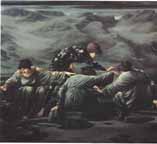 To find Medusa, Perseus must first seek out the sea nymphs who inhabit a cave on the island of Seriphos. The location of the island is known only to the Graiae, three Gorgon sisters, who have only one eye and one tooth between them. In Perseus and the Graiae Perseus snatches the eye while they are passing it amongst themselves, forcing the sisters to tell him the way. Once again, Burne-Jones sets the scene in a grey, barren, stylized landscape which recalls the "bleak emptiness" and "stark absence of color" in Souls on the Banks of the River Styx (Wilton 1997: 147). In this painting as in The Perseus Series, Burne-Jones adds weight and gravity to his forms without diminishing their characteristic ethereality. In his depiction of the beautiful gorgon sisters in Greek poses, Burne-Jones departs drastically from Morris's description of them as "crones" with "dreadful", "wrinkled" faces and "straight white hair." The faces of the gorgon sisters on the right are not visible, but the crouching sister on the left has her eyes cast downwards in a pose resembling D.G. Rossetti's portraits of Jane Morris, who often appears indolent or withdrawn in private reverie or pensive isolation. The duality of this female -- her powerlessness because she is restrained and yet her control of men because they desire her forms an important undercurrent in Rossetti's painting and poetry. Burne-Jones's women share with Rossetti's fair ladies a mystical silence, sensuous features, half-closed eyes, mesmerized stares and even potential danger.
To find Medusa, Perseus must first seek out the sea nymphs who inhabit a cave on the island of Seriphos. The location of the island is known only to the Graiae, three Gorgon sisters, who have only one eye and one tooth between them. In Perseus and the Graiae Perseus snatches the eye while they are passing it amongst themselves, forcing the sisters to tell him the way. Once again, Burne-Jones sets the scene in a grey, barren, stylized landscape which recalls the "bleak emptiness" and "stark absence of color" in Souls on the Banks of the River Styx (Wilton 1997: 147). In this painting as in The Perseus Series, Burne-Jones adds weight and gravity to his forms without diminishing their characteristic ethereality. In his depiction of the beautiful gorgon sisters in Greek poses, Burne-Jones departs drastically from Morris's description of them as "crones" with "dreadful", "wrinkled" faces and "straight white hair." The faces of the gorgon sisters on the right are not visible, but the crouching sister on the left has her eyes cast downwards in a pose resembling D.G. Rossetti's portraits of Jane Morris, who often appears indolent or withdrawn in private reverie or pensive isolation. The duality of this female -- her powerlessness because she is restrained and yet her control of men because they desire her forms an important undercurrent in Rossetti's painting and poetry. Burne-Jones's women share with Rossetti's fair ladies a mystical silence, sensuous features, half-closed eyes, mesmerized stares and even potential danger.
In Pre-Raphaelite painting, the woman usually represents an aesthetic allegory of sorts. Rossetti's subjects of embowered womanhood had forged the old formulas of female charm into a new paradoxical combination of innocence, sensuality and temptation, while artists like Aubrey Beardsley chose to depict more malevolent women. Burne-Jones's women belong to another category of enigmatic females endowed with a deliberate sense of abstraction and removal from everyday life.
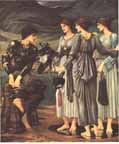 In the stark and noble oil Perseus and the Sea Nymphs, a scene that does not appear in Morris's narrative, Burne-Jones creates a visionary tableau in which absolute stillness reigns. In this image as in the rest of the Perseus Series, the persistent amber yellows, dull greens, greys and blues of the flowing costumes harmonize with aesthetic furnishings, screens, ornamentation and Morris wallpaper. Burne-Jones's women taken from legend exist in a remote and timeless realm of tranquil beauty. As in Perseus and the Graiae in which Burne-Jones generalizes his figures' features, the sea nymphs appear to be almost identical. The sea nymphs provide Perseus with the equipment he needs for his mission. Adopting an attitude of the Three Graces, the maidens offer him the winged sandals of Hermes, a helmet of invisibility and a magic pouch in which to place the Gorgon's head. In contrast to the nymphs who carry themselves in a graceful, Italianate style, Perseus assumes an awkward and unnatural sitting position.
In the stark and noble oil Perseus and the Sea Nymphs, a scene that does not appear in Morris's narrative, Burne-Jones creates a visionary tableau in which absolute stillness reigns. In this image as in the rest of the Perseus Series, the persistent amber yellows, dull greens, greys and blues of the flowing costumes harmonize with aesthetic furnishings, screens, ornamentation and Morris wallpaper. Burne-Jones's women taken from legend exist in a remote and timeless realm of tranquil beauty. As in Perseus and the Graiae in which Burne-Jones generalizes his figures' features, the sea nymphs appear to be almost identical. The sea nymphs provide Perseus with the equipment he needs for his mission. Adopting an attitude of the Three Graces, the maidens offer him the winged sandals of Hermes, a helmet of invisibility and a magic pouch in which to place the Gorgon's head. In contrast to the nymphs who carry themselves in a graceful, Italianate style, Perseus assumes an awkward and unnatural sitting position.
 The depiction of Perseus exemplifies the typical androgynous style of Burne-Jones's figures. Burne-Jones's Perseus can be compared to the figures in Simeon Solomon's Damon and Aglae, one of his characteristically androgynous drawings. Burne-Jones also influenced the work of Aubrey Beardsley who created figures that were "simultaneously heterosexual and androgynous, promiscuous and celibate, alluring and repulsive, malignant and innocent" (Castera 1987: 170). Among his most famous images is The Climax which appeared among illustrations for Oscar Wilde's play Salome. The "sinful" subject expressed in sinuous lines perfectly embodied the Art Nouveau style. It also typified the fin de siècle obsession with the voracious femme fatale who tormented men. In Beardsley's drawing, a floating Salome holds the severed bleeding head of John the Baptist and looks at it with cruel pleasure, a vivid departure from the sweet, demure conduct of Burne-Jones's sea nymphs.
The depiction of Perseus exemplifies the typical androgynous style of Burne-Jones's figures. Burne-Jones's Perseus can be compared to the figures in Simeon Solomon's Damon and Aglae, one of his characteristically androgynous drawings. Burne-Jones also influenced the work of Aubrey Beardsley who created figures that were "simultaneously heterosexual and androgynous, promiscuous and celibate, alluring and repulsive, malignant and innocent" (Castera 1987: 170). Among his most famous images is The Climax which appeared among illustrations for Oscar Wilde's play Salome. The "sinful" subject expressed in sinuous lines perfectly embodied the Art Nouveau style. It also typified the fin de siècle obsession with the voracious femme fatale who tormented men. In Beardsley's drawing, a floating Salome holds the severed bleeding head of John the Baptist and looks at it with cruel pleasure, a vivid departure from the sweet, demure conduct of Burne-Jones's sea nymphs.
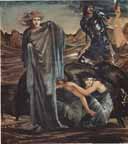 In Morris's poem, the scene for The Finding of Medusa takes place inside a "mighty" stone hall, but instead Burne-Jones's cartoon depicts an indeterminate cave-like setting in which Medusa looks distractedly into the distance while her sisters crouch in terror beneath their wings. Medusa, the classical fatal lady, dramatizes the fatal mix of beauty and female power which finds expression in Rossetti's fair ladies. Burne-Jones preferred to depict the legendary rather than the contemporary female, extending Rossetti's mood of fatal indolence into the realm of myth. Morris describes Medusa as having snakes entangled in her hair, but in his cartoon version Burne-Jones emphasizes only her powerful stare as if she has suddenly become aware of an intruder's presence from behind. Medusa's sisters are depicted with youthful bodies and skin tones, a departure from Morris's description of them as "two women bent and old" with "wrinkled hands." The figure of the Medusa represents a reversal of the Sleeping Beauty in The Briarose Series because "no god or man can set her free":
In Morris's poem, the scene for The Finding of Medusa takes place inside a "mighty" stone hall, but instead Burne-Jones's cartoon depicts an indeterminate cave-like setting in which Medusa looks distractedly into the distance while her sisters crouch in terror beneath their wings. Medusa, the classical fatal lady, dramatizes the fatal mix of beauty and female power which finds expression in Rossetti's fair ladies. Burne-Jones preferred to depict the legendary rather than the contemporary female, extending Rossetti's mood of fatal indolence into the realm of myth. Morris describes Medusa as having snakes entangled in her hair, but in his cartoon version Burne-Jones emphasizes only her powerful stare as if she has suddenly become aware of an intruder's presence from behind. Medusa's sisters are depicted with youthful bodies and skin tones, a departure from Morris's description of them as "two women bent and old" with "wrinkled hands." The figure of the Medusa represents a reversal of the Sleeping Beauty in The Briarose Series because "no god or man can set her free":
But therewith Pallas smote him with this thought,
"Does she desire to live, who has been brought
Into such utter woe and misery,
Wherefrom no god or man can set her free?" ["The Doom of King Acrisius," I, 259-60]
According to this legend, a woman who cannot be passive and subservient must be punished with death. After he kills the Medusa, Perseus uses her head as a weapon against his enemies.
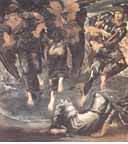 In the cartoon rendition of The Death of Medusa, Burne-Jones invents an image of dark horror and bitter frenzy that takes place in mid-air, a departure from Morris's more prosaic account which describes the action on the ground. Within this strange, almost surreal scene are references to classical sculpture in the body of the Medusa in the foreground, in the flowing draperies and in the athletic poses of all the figures. The previous paintings in the series have been static and ghostly compositions with figures assuming frozen, rigid poses. The most dramatic in the series, this composition captures a dynamic sense of energy as Perseus makes his escape from Medusa's enraged sisters, thrusting Medusa's head into his pouch as he flies off.
In the cartoon rendition of The Death of Medusa, Burne-Jones invents an image of dark horror and bitter frenzy that takes place in mid-air, a departure from Morris's more prosaic account which describes the action on the ground. Within this strange, almost surreal scene are references to classical sculpture in the body of the Medusa in the foreground, in the flowing draperies and in the athletic poses of all the figures. The previous paintings in the series have been static and ghostly compositions with figures assuming frozen, rigid poses. The most dramatic in the series, this composition captures a dynamic sense of energy as Perseus makes his escape from Medusa's enraged sisters, thrusting Medusa's head into his pouch as he flies off.
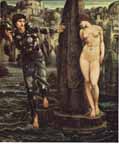 In the oil painting The Rock of Doom Burne-Jones conforms more to Morris's verse. For the first time in the series, the background features an elaborate cityscape rather than just a vague, dreamy backdrop. On his way back to Seriphos, Perseus catches sight of Andromeda who has been offered as a sacrifice to the sea god Poseidon. The dark and grim surroundings contrast starkly with her pale, luminous skin. Whereas the other females appearing in the series drift across the barren landscapes with enigmatic, wraithlike beauty, Andromeda stands naked and exposed and chained to a rock, desperately waiting for a rescuer. In Morris's poem, her loneliness and her suffering are sentimentalized and become an integral part of her appeal. Burne-Jones focuses on the moment at which Perseus reveals himself by removing his helmet of invisibility. In The Briarose Series, the Sleeping Beauty is the archetype of the passive, waiting beauty. Like the Sleeping Beauty, Andromeda seems to exist passively until she is seen by the hero. The heroines are not allowed to act upon their world, and instead they are acted upon -- both wait, are chosen and are saved.
In the oil painting The Rock of Doom Burne-Jones conforms more to Morris's verse. For the first time in the series, the background features an elaborate cityscape rather than just a vague, dreamy backdrop. On his way back to Seriphos, Perseus catches sight of Andromeda who has been offered as a sacrifice to the sea god Poseidon. The dark and grim surroundings contrast starkly with her pale, luminous skin. Whereas the other females appearing in the series drift across the barren landscapes with enigmatic, wraithlike beauty, Andromeda stands naked and exposed and chained to a rock, desperately waiting for a rescuer. In Morris's poem, her loneliness and her suffering are sentimentalized and become an integral part of her appeal. Burne-Jones focuses on the moment at which Perseus reveals himself by removing his helmet of invisibility. In The Briarose Series, the Sleeping Beauty is the archetype of the passive, waiting beauty. Like the Sleeping Beauty, Andromeda seems to exist passively until she is seen by the hero. The heroines are not allowed to act upon their world, and instead they are acted upon -- both wait, are chosen and are saved.
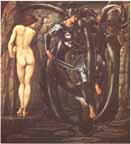 Having released Andromeda from her chains, Perseus fights with the sea monster which Morris describes as being "maned with grey tufts of hair, as some old tree / Hung round with moss." In his corresponding oil, The Doom Fulfilled, Burne-Jones has in mind something more like an actual sea serpent with blue-black coils burnished like Perseus's own armor. The pouch slung from Perseus's arm has been eliminated, allowing for a clearer focus on his sword which Morris calls his "blue-edged Herpe." The depiction of Andromeda standing in contrapposto strongly recalls classical sculpture. Burne-Jones's Andromeda deviates from Morris's description of her:
Having released Andromeda from her chains, Perseus fights with the sea monster which Morris describes as being "maned with grey tufts of hair, as some old tree / Hung round with moss." In his corresponding oil, The Doom Fulfilled, Burne-Jones has in mind something more like an actual sea serpent with blue-black coils burnished like Perseus's own armor. The pouch slung from Perseus's arm has been eliminated, allowing for a clearer focus on his sword which Morris calls his "blue-edged Herpe." The depiction of Andromeda standing in contrapposto strongly recalls classical sculpture. Burne-Jones's Andromeda deviates from Morris's description of her:
Then Perseus gently put the maid from him,
Who sank down shivering in her every limb,
Silent despite herself for fear and woe,
As down the beach he ran to meet the foe.
Burne-Jones's Andromeda does not seem as frightened as Morris describes her, but she still remains submissive, helpless and motionless while Perseus fights with the sea monster.
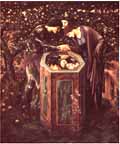 In the oil painting The Baleful Head, Perseus shows Andromeda the head of the Medusa in the reflection of a well in order to convince her of his divine origins and win her hand in marriage. The heroic proportions of the figures and the sculpted folds in their robes typify Burne-Jones's late style. In this painting Perseus appears less androgynous and more fully masculine than in The Call of Perseus where the goddess Pallas, a female of grand proportions, towers over him. After Perseus has completed his mission by slaying the Medusa and rescuing Andromeda along the way, he exudes full-bodied masculine strength instead of his former anxiety and uncertainty. As in the Sleeping Beauty myth, submissive, passive female behavior is rewarded with marriage. Underlying the Perseus story is the assumption that rescue and preservation by the male is not necessarily synonymous with liberation. After the bleak, unearthly settings of the previous scenes, the flowering classical garden in The Baleful Head comes as a welcome relief. The richly grained, smooth marble surfaces contrast starkly with the harsh, rocky terrains in the preceding scenes of the series.
In the oil painting The Baleful Head, Perseus shows Andromeda the head of the Medusa in the reflection of a well in order to convince her of his divine origins and win her hand in marriage. The heroic proportions of the figures and the sculpted folds in their robes typify Burne-Jones's late style. In this painting Perseus appears less androgynous and more fully masculine than in The Call of Perseus where the goddess Pallas, a female of grand proportions, towers over him. After Perseus has completed his mission by slaying the Medusa and rescuing Andromeda along the way, he exudes full-bodied masculine strength instead of his former anxiety and uncertainty. As in the Sleeping Beauty myth, submissive, passive female behavior is rewarded with marriage. Underlying the Perseus story is the assumption that rescue and preservation by the male is not necessarily synonymous with liberation. After the bleak, unearthly settings of the previous scenes, the flowering classical garden in The Baleful Head comes as a welcome relief. The richly grained, smooth marble surfaces contrast starkly with the harsh, rocky terrains in the preceding scenes of the series.
 The Perseus Series offers an example of late Pre-Raphaelite visionary art, a style which had its roots in the works of earlier Pre-Raphaelite painters and poets. According to the Tate catalogue, in Autumn Leaves John Everett Millais "sets out to paint a picture full of beauty and without subject,' a work in which the very specific story-telling that plays such an important part in his paintings of the early 1850's is replaced by a concern for creating a mood and suggesting more universal ideas" (139). The wistful feeling imparted by the drifting smoke and the solemn beauty of the evening landscape soon to be engulfed in darkness requires no literal interpretation, only poetic imagination. Literature also often took the form of works without theme. For example, Tennyson's "The Kraken" and "Mariana" do not have a theme nor do they have any moral or didactic intention. Rather, their main purpose like that of the Decadents was to create a mood or effect. In "'Too beautiful not to be true': Edward Burne-Jones," Debra Mancoff says that "Burne-Jones conceived his art as an alternative, a vision of the boundless potential of the human body and spirit." The escapist, dreamy feeling of Burne-Jones's paintings also recalls the somber, romantic atmosphere of suffused color in Rossetti's Beata Beatrix, an idealized, ethereal portrait of Elizabeth Siddal in the role of Beatrice painted against a blurred background. While Rossetti and Burne-Jones both strive to achieve similar moods, Burne-Jones's female bodies are eminently more substantial and classicizing.
The Perseus Series offers an example of late Pre-Raphaelite visionary art, a style which had its roots in the works of earlier Pre-Raphaelite painters and poets. According to the Tate catalogue, in Autumn Leaves John Everett Millais "sets out to paint a picture full of beauty and without subject,' a work in which the very specific story-telling that plays such an important part in his paintings of the early 1850's is replaced by a concern for creating a mood and suggesting more universal ideas" (139). The wistful feeling imparted by the drifting smoke and the solemn beauty of the evening landscape soon to be engulfed in darkness requires no literal interpretation, only poetic imagination. Literature also often took the form of works without theme. For example, Tennyson's "The Kraken" and "Mariana" do not have a theme nor do they have any moral or didactic intention. Rather, their main purpose like that of the Decadents was to create a mood or effect. In "'Too beautiful not to be true': Edward Burne-Jones," Debra Mancoff says that "Burne-Jones conceived his art as an alternative, a vision of the boundless potential of the human body and spirit." The escapist, dreamy feeling of Burne-Jones's paintings also recalls the somber, romantic atmosphere of suffused color in Rossetti's Beata Beatrix, an idealized, ethereal portrait of Elizabeth Siddal in the role of Beatrice painted against a blurred background. While Rossetti and Burne-Jones both strive to achieve similar moods, Burne-Jones's female bodies are eminently more substantial and classicizing.
Burne-Jones's enigmatic dream worlds influenced his followers who cultivated their own idiosyncratic inner visions. John Roddham Stanhope registers as part of a long established tradition of visionary painters stretching back through Burne-Jones and Rossetti. For example, in his watercolor The Winepress the evocation of mood and decorative beauty take precedence over narrative. Evelyn De Morgan, Stanhope's niece, produced many large-scale paintings of literary and allegorical subjects which also show the influence of Burne-Jones. In The Vision De Morgan creates a mysterious and haunting atmosphere which recalls the "Never-Never Land" quality of Burne-Jones's works (Landow). In the manner of Symbolist art, The Vision privileges strange moods and ambiguity over clarity of narrative. Dorment describes De Morgan's style as "more precise, less willful than Burne-Jones, more simple, more direct than Rossetti, more colorful than Hunt" (Dorment 2003: 25).
Death, sleep, dreams and the romantic tragedy of early death are woven together in major paintings by Rossetti such as Beata Beatrix and Dante's Dream at the Time of the Death of Beatrice. The Symbolists in France were also interested in "morbid yet hauntingly beautiful images of introspection and meditation" (Lambourne 1996: 193). Burne-Jones used the motif of the sleeping woman in his series of paintings The Legend of the Briarose. When completed in 1890 the Series comprised four paintings: The Prince Entering the Briar Wood, The Garden Court depicting a group of servant girls asleep at their work, The King and his Courtiers Asleep and The Princess and Her Maidens Alseep. The somnolent states in these paintings repeat the Pre-Raphaelite preoccupation with female dreamers. In The Princess and Her Maidens Asleep the figure of the Sleeping Beauty frozen in death-like sleep becomes an emblem for sensuality and passivity. By contrast, Swinburne's poem entitled "Laus Veneris" describes in detail the goddess in deep and dangerous sleep as well as how her beautiful mouth and hair could sear a lover's flesh. In a claustrophobic chamber of love, she inflicts both pleasure and pain on her admirers and according to the male speaker, seems nearly consumed by her "unassuaged desires." Swinburne like Burne-Jones uses subjects from myth for their unworldly, distancing effect. Swinburne's Venus finds its antithesis in the Sleeping Beauty who must be awakened by the man before she can love physically and spiritually. Lambourne informs us that "the depiction of sleep became one of the most potent themes of the Aesthetic art. On the whole, women are more often portrayed asleep than men. In sleep, problems of the relationship between men and women are postponed so that the sleeping person for the viewer becomes an object of admiration or worship and physical involvement is sublimated" (Lambourne 1996: 195).
Like The Perseus Cycle, the Pygmalion and the Image paintings derive from drawings made as part of a proposed illustrated edition of Morris's cycle of poems The Earthly Paradise. The Pygmalion series also epitomizes the tension between early Pre-Raphaelite sensuality and the classicizing tendencies of the late movement. A first set of small oils was commissioned in 1868 and completed in 1870. Burne-Jones painted the series a second time in 1875-1878 on a larger scale with a brighter palette and a sharper, clearer handling of detail and tone.
The deep repose of sleep in The Briarose Series and the pale immobile trance in Beata Beatrice both enact the statuesque passivity of Galatea in the Pygmalion story. The woman serves to complete the male artist's own lack of fullness by reflecting back at him the fantasies he most enjoys. The figure of Pygmalion recalls many of the self-obsessed male speakers in Robert Browning's poetry. The misogyny of Pygmalion for whom no living woman meets his standards can be compared to the Duke in Browning's "My Last Duchess" who substitutes a portrait over which he has complete control for the living Duchess. Pygmalion literally molds a woman to reflect his own fantasies. Similarly, in "Porphyria's Lover," the controlling male speaker's attempt to falsely represent Porphyria's behavior as self-centered is in fact a reflection of himself. The idea of a narcissistic male's sexual mastery of a woman in the Pygmalion series echoes the sexist notions of the myth of Andromeda's rescue by Perseus in which the female depends on the male to save and liberate her.
 In The Heart Desires Pygmalion muses over the perfection of the female form as represented by a sculpture group in the attitude of the Three Graces in the far right corner of the room. Influenced by High Renaissance masterworks, Burne-Jones creates figures of solidity and dignity. Female beauty represented by the cold ideal of sculpture contrasts with the vitality of the two frivolous local girls who pass by the door of Pygmalion's studio. In the polished marble floor, Burne-Jones gives the Three Graces an abstract pattern of reflections which anticipate Modernism.
In The Heart Desires Pygmalion muses over the perfection of the female form as represented by a sculpture group in the attitude of the Three Graces in the far right corner of the room. Influenced by High Renaissance masterworks, Burne-Jones creates figures of solidity and dignity. Female beauty represented by the cold ideal of sculpture contrasts with the vitality of the two frivolous local girls who pass by the door of Pygmalion's studio. In the polished marble floor, Burne-Jones gives the Three Graces an abstract pattern of reflections which anticipate Modernism.

 The more detailed scene in Hand Refrains focuses on the smooth perfection of the female form the sculptor has created. The pile of rough chippings at the sculpted woman's feet act as a foil to the smooth surfaces of Galatea's body and call attention to the sculptor's skill in carving life out of inanimate material. The weird anxiety and claustrophobia of the architectural spaces recalls the atmospheric aesthetic governing the work of Italian Mannerist painters. In The Hand Refrains the marble statue representing his own projections and conceptions of the feminine ideal fills Pygmalion with desire and Venus answers his prayers by transforming the marble statue into flesh in The Godhead Fires. In contrast to the Sleeping Beauty myth in which the woman depends on the man to awaken her with a kiss, this series emphasizes the role of a female, Venus, in bringing the woman to life. In The Godhead Fires which depicts Venus with Pygmalion's creation, Galatea, the figure of Venus has been made more unearthly by the substitution of a delicate, diaphanous material for the heavy drapery usually worn by Burne-Jones's figures. Venus holds a branch in her left arm while her right arm intertwines with those of Galatea who has been released from her frozen posture. The intertwined arms and curved body of Galatea anticipate the sinuous forms associated with Art Nouveau in the 1890s.
The more detailed scene in Hand Refrains focuses on the smooth perfection of the female form the sculptor has created. The pile of rough chippings at the sculpted woman's feet act as a foil to the smooth surfaces of Galatea's body and call attention to the sculptor's skill in carving life out of inanimate material. The weird anxiety and claustrophobia of the architectural spaces recalls the atmospheric aesthetic governing the work of Italian Mannerist painters. In The Hand Refrains the marble statue representing his own projections and conceptions of the feminine ideal fills Pygmalion with desire and Venus answers his prayers by transforming the marble statue into flesh in The Godhead Fires. In contrast to the Sleeping Beauty myth in which the woman depends on the man to awaken her with a kiss, this series emphasizes the role of a female, Venus, in bringing the woman to life. In The Godhead Fires which depicts Venus with Pygmalion's creation, Galatea, the figure of Venus has been made more unearthly by the substitution of a delicate, diaphanous material for the heavy drapery usually worn by Burne-Jones's figures. Venus holds a branch in her left arm while her right arm intertwines with those of Galatea who has been released from her frozen posture. The intertwined arms and curved body of Galatea anticipate the sinuous forms associated with Art Nouveau in the 1890s.
 In The Soul Attains, the sculptor kneels before his now mortal love. The rich, angular folds of Pygmalion's robe and cloak reflect Burne-Jones's interest in drapery studies. According to Mancoff, Burne-Jones merged his Classical and Medieval sources into an "aesthetic synthesis" (Mancoff 2003: 65). A variation of the relationship between Pygmalion and Galatea appears in King Cophetua and the Beggar Maid. The subject of the painting derives from the story of Cophetua, "an ancient African king who disdained women and was immune to love. However, one day he saw a beggar girl, and, falling instantly in love with her, vowed to make her his queen" (Wilton 1997: 147). In possessing the poor and humble maid as his own, in introducing her to a new life and new experiences, the King re-creates her in the image of his choice. The King falls in love with the beggar maid who sits unnervingly still and appears drained of emotion like the sculpted image of Galatea. Like the artist who creates life out of inanimate material, it is the role of the King to bring the passive woman to life. In The Perseus Cycle, The Briarose Series and The Pygmalion Series, the female heroines are never allowed to assert their own image and significance. Each story depicts a power relation in which the woman depends on the man to free her and animate her. In each myth, the man strives for possession and completion.
In The Soul Attains, the sculptor kneels before his now mortal love. The rich, angular folds of Pygmalion's robe and cloak reflect Burne-Jones's interest in drapery studies. According to Mancoff, Burne-Jones merged his Classical and Medieval sources into an "aesthetic synthesis" (Mancoff 2003: 65). A variation of the relationship between Pygmalion and Galatea appears in King Cophetua and the Beggar Maid. The subject of the painting derives from the story of Cophetua, "an ancient African king who disdained women and was immune to love. However, one day he saw a beggar girl, and, falling instantly in love with her, vowed to make her his queen" (Wilton 1997: 147). In possessing the poor and humble maid as his own, in introducing her to a new life and new experiences, the King re-creates her in the image of his choice. The King falls in love with the beggar maid who sits unnervingly still and appears drained of emotion like the sculpted image of Galatea. Like the artist who creates life out of inanimate material, it is the role of the King to bring the passive woman to life. In The Perseus Cycle, The Briarose Series and The Pygmalion Series, the female heroines are never allowed to assert their own image and significance. Each story depicts a power relation in which the woman depends on the man to free her and animate her. In each myth, the man strives for possession and completion.
Over the course of his career, Burne-Jones developed from the "dreamy amateur" to the successful designer of stained glass for Morris & Co. to the leading Aesthete in the British school and the "idol of the French symbolists" (Dorment 2003: 21). Burne-Jones's work combines both Pre-Raphaelite ideals and Aesthetic principles in a synthesis that reflects the rapidly changing artistic standards of his times. Burne-Jones was among a generation of young British painters who began to abandon pure Pre-Raphaelitism in order to explore classicism (Dorment 2003: 23). Narrative considerations were being increasingly abandoned in favor of mood and poetic sentiment, introspection and psychological power. Instead of the narrative subject and elaborate symbolism of works such as Holman Hunt's The Finding of the Saviour in the Temple and Rossetti's Found, Burne-Jones used pose and gesture to establish a mood or effect. From here it was but a step to the full-blown symbolism found in later works such as Giovanni Segantini's strange and disturbing Punishment of Lust (1891). As a leading artist in the Aesthetic phase of the Pre-Raphaelite movement, Burne-Jones established new standards for purely aesthetic creation which allowed artist and viewer to transcend the gross materialism of the age.
Bibliography
Bullen, J.B. The Pre-Raphaelite Body: Fear and Desire in Painting, Poetry and Criticism. Oxford: Clarendon Press, 1998.
Castera, Susan P. Images of Victorian Womanhood in English Art. Rutherford, NJ: Fairleigh Dickinson University Press, 1987.
Dorment, Richard. "Realists and Romantics, Storytellers and Symbolists: Changing Attitudes Towards Victorian Painting in the 20th Century." Pre-Raphaelites and Other Masters: The Andrew Lloyd Webber Collection. London: Royal Academy of Arts: 2003.
Lambourne, Lionel. The Aesthetic Movement. London: Paidon Press Ltd., 1996.
Mancoff, Debra N. "'Too beautiful not to be true': Edward Burne-Jones." Pre-Raphaelite and Other Masters: The Andrew Lloyd Webber Collection. London: Royal Academy of Arts, 2003.
Marcus, Penelope ed. Burne-Jones: The paintings, graphic and decorative work of Sir Edward Burne-Jones 1833-98. London: The Arts Council of Great Britain, 1975.
The Pre-Raphaelites. London: The Tate Gallery: A. Lane, 1984.
Trumble, Angus. Love and Death: Art in the Age of Queen Victoria. Adelaide: Art Gallery of South Australia, 2002.
Welby, T. Earle. The Victorian Romantics 1850-70: The Early Work of Dante Gabriel Rossetti, William Morris, Burne-Jones, Swinburne, Simeon Solomon and Their Associates. London: Frank Cass & Co., Ltd., 1996.
Wildman, Stephen and John Christian. Edward Burne-Jones, Victorian Artist-Dreamer. New York: The Metropolitan Museum of Art, 1998.
Wilton, Andrew and Robert Upstone, editors. The Age of Rossetti, Burne-Jones & Watts: Symbolism in Britain 1860-1910. London: Tate Gallery Publishing Ltd., 1997.
Wood, Christopher. The Pre-Raphaelites. London: Weidenfeld and Nicolson, 1981.
Wood, Christopher. Burne-Jones: The Life and Works of Sir Edward Burne-Jones (1833-1898). New York: Stewart, Tabori and Chang, 1998.
Last modified 18 December 2004